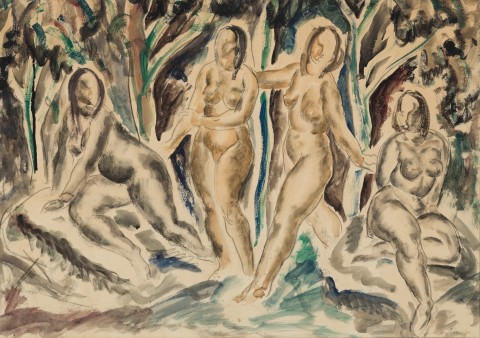COMPOSITION, 1937
RUSSELL DRYSDALE
watercolour and pencil on paper on card
48.0 x 68.0 cm
signed and dated lower right: Russell Drysdale ‘37
George Bell, Melbourne
Thence by descent
Antoinette Niven, Melbourne, the artist’s daughter
Private collection, Melbourne
Deutscher and Hackett, Melbourne, 29 August 2012, lot 53
Private collection, Sydney
The Drawings of Russell Drysdale, 1980 Perth Survey of Drawing, Art Gallery of Western Australia, Perth, 21 February – 15 March 1980; and then touring to Art Gallery of New South Wales, Sydney, 12 April – 18 May 1980; Brisbane Civic Art Gallery and Museum, Brisbane, 2 July – 1 August 1980; Art Gallery of South Australia, Adelaide, 6 September – 19 October 1980 (label attached verso)
Klepac, L., The Drawings of Russell Drysdale, 1980 Perth Survey of Drawing, Art Gallery of Western Australia, Perth, 1980, cat. 6, pl. 3, pp. 53, 68 (illus.)
Eagle, M., and Minchin, J., The George Bell School: Students, Friends and Influences, Deutscher Art Publications, Melbourne, 1981, p. 96 (illus.)
Klepac, L., The Life and Work of Russell Drysdale, Bay Books, Sydney, 1983, pp. 197, 365, pl. 8 (illus. as ’Composition (Nudes)’)
Klepac, L., Russell Drysdale The Drawings, The Beagle Press, Sydney, 2012, pp. 22 (illus.), 167
We are grateful to Brenda Martin Thomas, wife of the late David Thomas AM, for kindly allowing us to reproduce David’s research and writing in this catalogue entry.
Composition, 1937 comes from the time Russell Drysdale was at the George Bell Bourke Street school where the achievements of Paul Cézanne were much admired. Thus, not surprisingly perhaps, the work displays Drysdale’s then considerable interest in the French master, reproductions of whose work he had seen at Gino Nibbi’s Leonardo Art Shop. Fellow student Geoff Jones recalled Drysdale ‘coming into the studio one day ‘full of excitement. He’d seen more Cézanne prints at Nibbi’s of such good quality you could see the paint surface.’1 It was a period of intense learning, as Drysdale later remarked, ‘Every influence around the place flooded me, and I seized it.’2 This lively influence of Cézanne on the early work of Drysdale is seen at its best in Composition 1937. While present in other watercolour drawings of the time such as The Card Players, 1935/37 and Stacking Wood, Heidelberg, 1937, Composition has a special grandeur about it. Recalling in subject and composition the great Bathers paintings of Cézanne, Drysdale’s female forms are likewise pleasingly rotund. Moreover, the vibrancy of the composition is achieved by a similar interplay between dynamic diagonals and the vivacity of the lights and darks across the picture plane. Frieze-like, it has a certain classical, monumental quality which one associates with grand large-sized compositions or murals. This same quality can be found in other works of 1937, including the pen, ink and water colour Sketch for Tempera Composition and the oil painting Men Mixing Concrete, both of which were included in the Drysdale retrospective exhibition at the Art Gallery of New South Wales in 1960.
Another important influence was Ian Fairweather. Drysdale, like his fellow students, was greatly impressed by Fairweather’s work, as seen in the design and flowing, arabesque lines of Composition. In recollection, Drysdale said, ‘I was affected by Fairweather because he was to me the first example of a draughtsman that I’d seen. He had a quality that to my uninformed mind was unmistakable.’3 Writing the foreword to the exhibition of drawings at Joseph Brown’s Gallery in 1981, Patrick McCaughey observed, ‘Russell Drysdale’s gifts as a draughtsman were recognised from the start and they have remained central to any understanding and appreciation of his art.’4 Composition reveals the influence of Bell’s teaching and the work of Cézanne and Fairweather on the gifted Drysdale at an important stage in his development. They are the attire, as it were, in which he then clothed his progressive realisation of his prodigious talent leading to the extraordinary individuality of his images of outback Australia and Australians. A key step in this development, Composition is, accordingly, a very commanding work in its own right.
1. Jones cited in Eagle, M., and Minchin, J., The George Bell School: Students, Friends and Influences, Deutscher Art Publications, Melbourne, 1981, p. 96. Drysdale’s interest went so far that he even bought a copy of Fritz Novotnoy’s book on Cézanne, published that same year of 1937.
2. Drysdale, film transcript interview, Visual Arts Board, Australia Council, Sydney, 1975, cited in Klepac, L., The Life and Work of Russell Drysdale, Bay Books, Sydney, 1983, p. 25
3. Drysdale cited in Eagle, op. cit., p. 96. Significantly, Drysdale owned one of Fairweather’s paintings at this time.
4. McCaughey, P., ‘Foreword’, Russell Drysdale Drawings 1935 – 1980, Joseph Brown Gallery, Melbourne, 1980, n.p.
